Comparative Analysis: Flat vs. Holacratic Organizational Structures
VerifiedAdded on 2022/11/18
|6
|1000
|483
Report
AI Summary
This report delves into two distinct organizational structures: flat and holacratic. It contrasts their characteristics, advantages, and disadvantages within the context of Human Resource Management (HRM). The report highlights that flat organizations, with fewer hierarchical levels, can foster quick decision-making and increased employee involvement, while also risking standardization and coordination. Holacratic structures, emphasizing transparency and self-management, are examined for their potential to reduce conflicts and enhance employee commitment, alongside challenges like economic downturn vulnerability. The report then uses Zappos as a case study to illustrate the practical application of a holacratic structure, exploring the company's transition and the associated challenges and successes. The discussion extends to social innovations within organizations, emphasizing the role of social capital and leadership in achieving organizational goals. The report concludes by acknowledging the suitability of these structures for specific organizational contexts and the significance of leadership in driving organizational change and effectiveness.
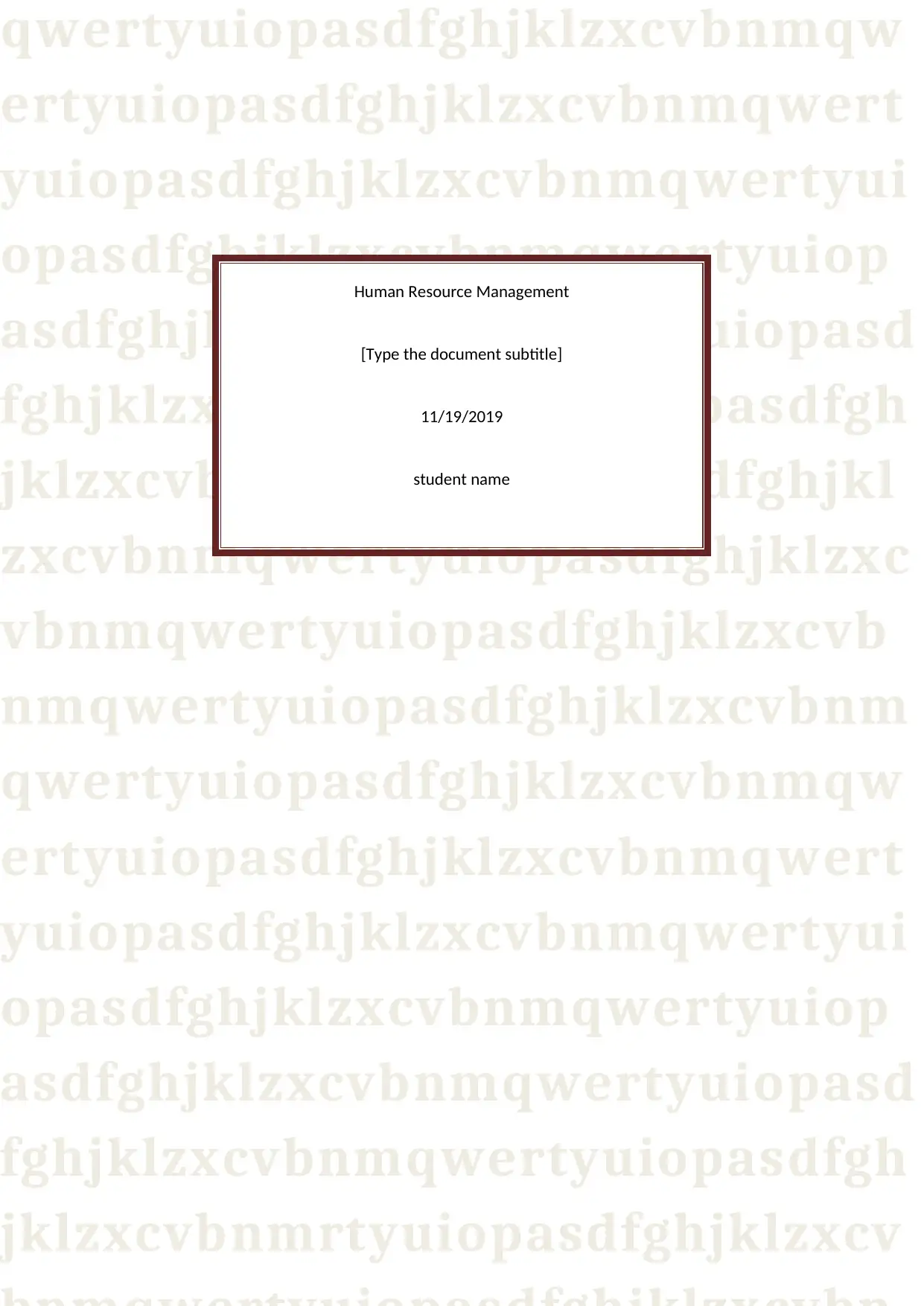
qwertyuiopasdfghjklzxcvbnmqw
ertyuiopasdfghjklzxcvbnmqwert
yuiopasdfghjklzxcvbnmqwertyui
opasdfghjklzxcvbnmqwertyuiop
asdfghjklzxcvbnmqwertyuiopasd
fghjklzxcvbnmqwertyuiopasdfgh
jklzxcvbnmqwertyuiopasdfghjkl
zxcvbnmqwertyuiopasdfghjklzxc
vbnmqwertyuiopasdfghjklzxcvb
nmqwertyuiopasdfghjklzxcvbnm
qwertyuiopasdfghjklzxcvbnmqw
ertyuiopasdfghjklzxcvbnmqwert
yuiopasdfghjklzxcvbnmqwertyui
opasdfghjklzxcvbnmqwertyuiop
asdfghjklzxcvbnmqwertyuiopasd
fghjklzxcvbnmqwertyuiopasdfgh
jklzxcvbnmrtyuiopasdfghjklzxcv
Human Resource Management
[Type the document subtitle]
11/19/2019
student name
ertyuiopasdfghjklzxcvbnmqwert
yuiopasdfghjklzxcvbnmqwertyui
opasdfghjklzxcvbnmqwertyuiop
asdfghjklzxcvbnmqwertyuiopasd
fghjklzxcvbnmqwertyuiopasdfgh
jklzxcvbnmqwertyuiopasdfghjkl
zxcvbnmqwertyuiopasdfghjklzxc
vbnmqwertyuiopasdfghjklzxcvb
nmqwertyuiopasdfghjklzxcvbnm
qwertyuiopasdfghjklzxcvbnmqw
ertyuiopasdfghjklzxcvbnmqwert
yuiopasdfghjklzxcvbnmqwertyui
opasdfghjklzxcvbnmqwertyuiop
asdfghjklzxcvbnmqwertyuiopasd
fghjklzxcvbnmqwertyuiopasdfgh
jklzxcvbnmrtyuiopasdfghjklzxcv
Human Resource Management
[Type the document subtitle]
11/19/2019
student name
Paraphrase This Document
Need a fresh take? Get an instant paraphrase of this document with our AI Paraphraser
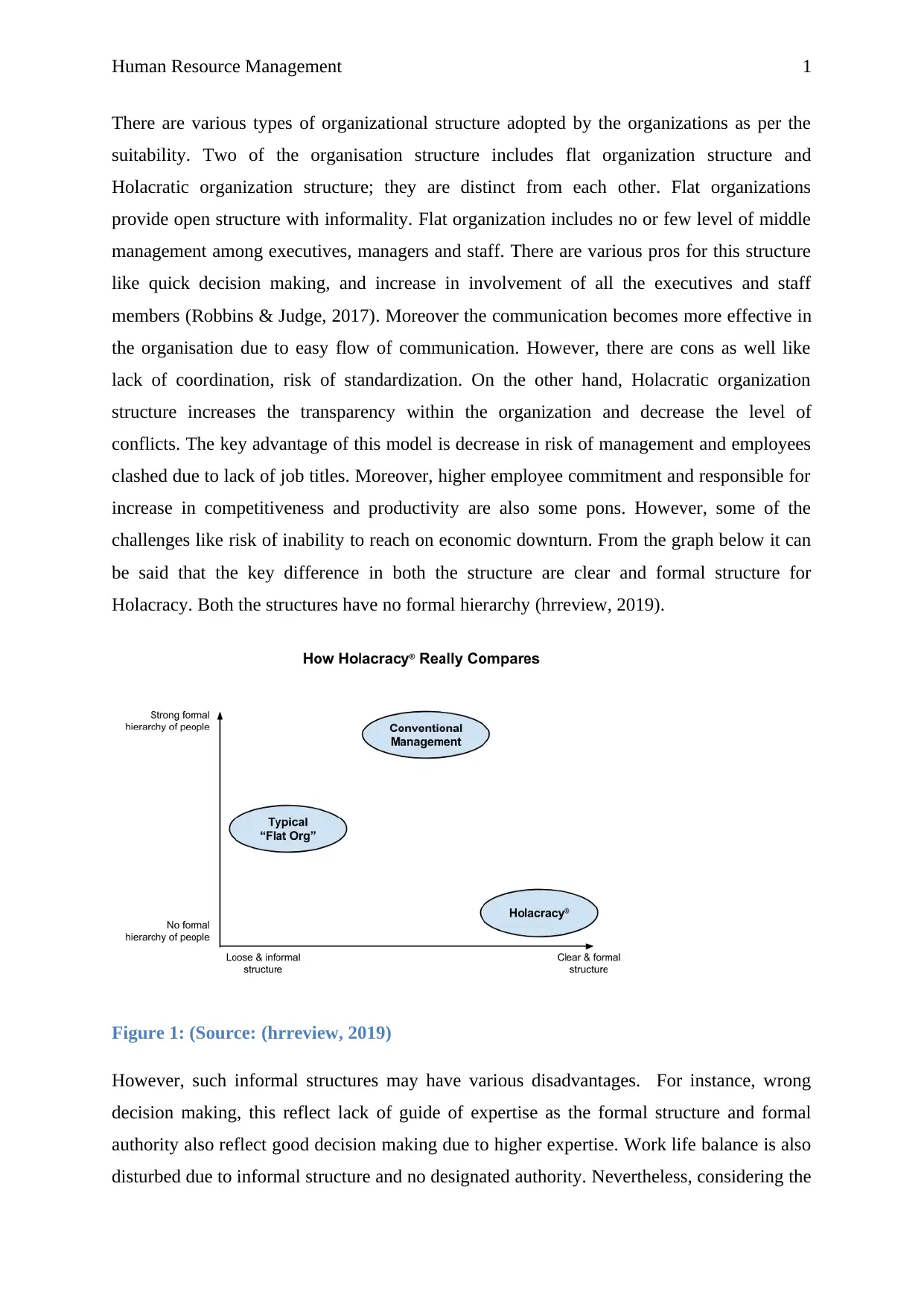
Human Resource Management 1
There are various types of organizational structure adopted by the organizations as per the
suitability. Two of the organisation structure includes flat organization structure and
Holacratic organization structure; they are distinct from each other. Flat organizations
provide open structure with informality. Flat organization includes no or few level of middle
management among executives, managers and staff. There are various pros for this structure
like quick decision making, and increase in involvement of all the executives and staff
members (Robbins & Judge, 2017). Moreover the communication becomes more effective in
the organisation due to easy flow of communication. However, there are cons as well like
lack of coordination, risk of standardization. On the other hand, Holacratic organization
structure increases the transparency within the organization and decrease the level of
conflicts. The key advantage of this model is decrease in risk of management and employees
clashed due to lack of job titles. Moreover, higher employee commitment and responsible for
increase in competitiveness and productivity are also some pons. However, some of the
challenges like risk of inability to reach on economic downturn. From the graph below it can
be said that the key difference in both the structure are clear and formal structure for
Holacracy. Both the structures have no formal hierarchy (hrreview, 2019).
Figure 1: (Source: (hrreview, 2019)
However, such informal structures may have various disadvantages. For instance, wrong
decision making, this reflect lack of guide of expertise as the formal structure and formal
authority also reflect good decision making due to higher expertise. Work life balance is also
disturbed due to informal structure and no designated authority. Nevertheless, considering the
There are various types of organizational structure adopted by the organizations as per the
suitability. Two of the organisation structure includes flat organization structure and
Holacratic organization structure; they are distinct from each other. Flat organizations
provide open structure with informality. Flat organization includes no or few level of middle
management among executives, managers and staff. There are various pros for this structure
like quick decision making, and increase in involvement of all the executives and staff
members (Robbins & Judge, 2017). Moreover the communication becomes more effective in
the organisation due to easy flow of communication. However, there are cons as well like
lack of coordination, risk of standardization. On the other hand, Holacratic organization
structure increases the transparency within the organization and decrease the level of
conflicts. The key advantage of this model is decrease in risk of management and employees
clashed due to lack of job titles. Moreover, higher employee commitment and responsible for
increase in competitiveness and productivity are also some pons. However, some of the
challenges like risk of inability to reach on economic downturn. From the graph below it can
be said that the key difference in both the structure are clear and formal structure for
Holacracy. Both the structures have no formal hierarchy (hrreview, 2019).
Figure 1: (Source: (hrreview, 2019)
However, such informal structures may have various disadvantages. For instance, wrong
decision making, this reflect lack of guide of expertise as the formal structure and formal
authority also reflect good decision making due to higher expertise. Work life balance is also
disturbed due to informal structure and no designated authority. Nevertheless, considering the
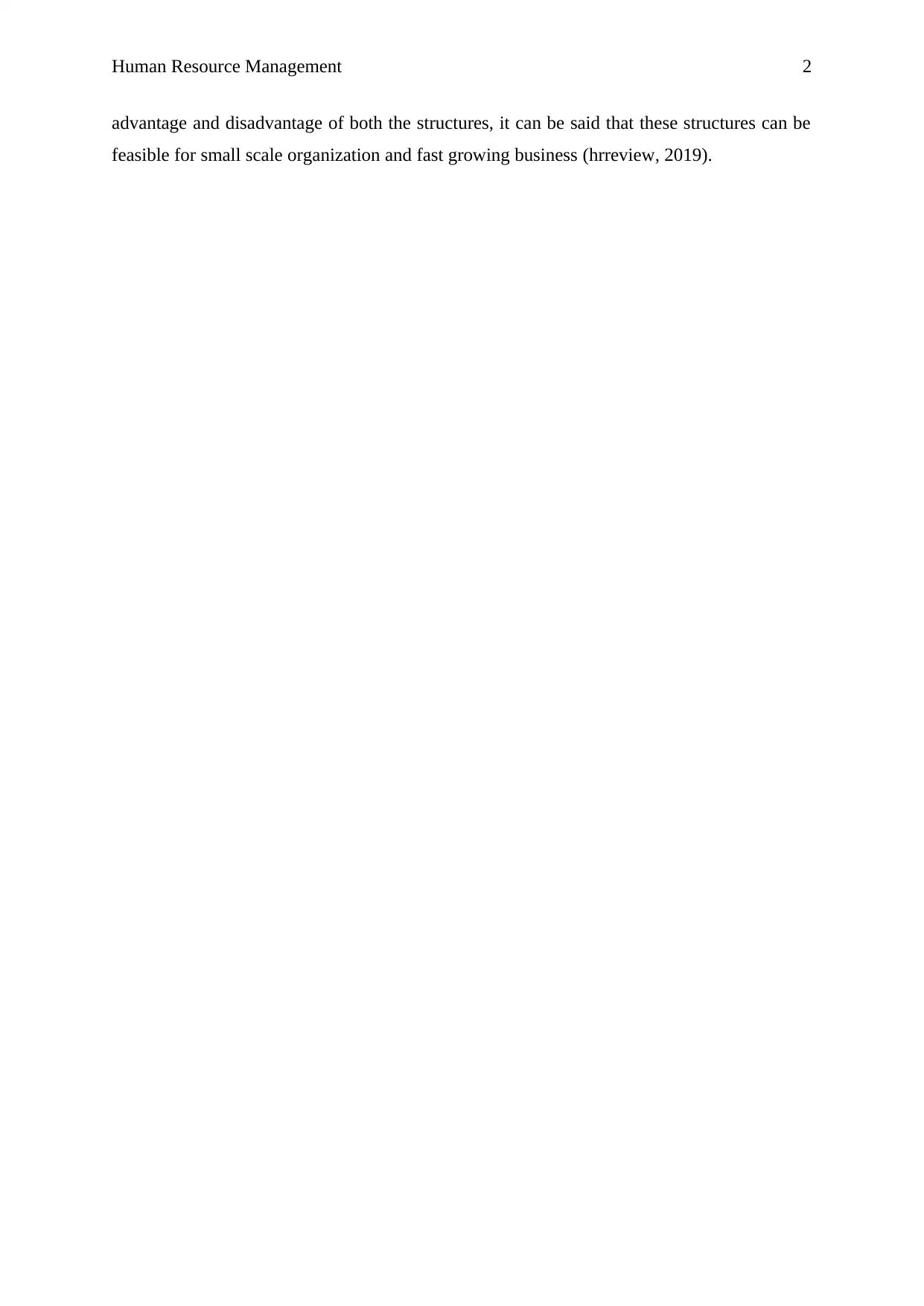
Human Resource Management 2
advantage and disadvantage of both the structures, it can be said that these structures can be
feasible for small scale organization and fast growing business (hrreview, 2019).
advantage and disadvantage of both the structures, it can be said that these structures can be
feasible for small scale organization and fast growing business (hrreview, 2019).
⊘ This is a preview!⊘
Do you want full access?
Subscribe today to unlock all pages.

Trusted by 1+ million students worldwide
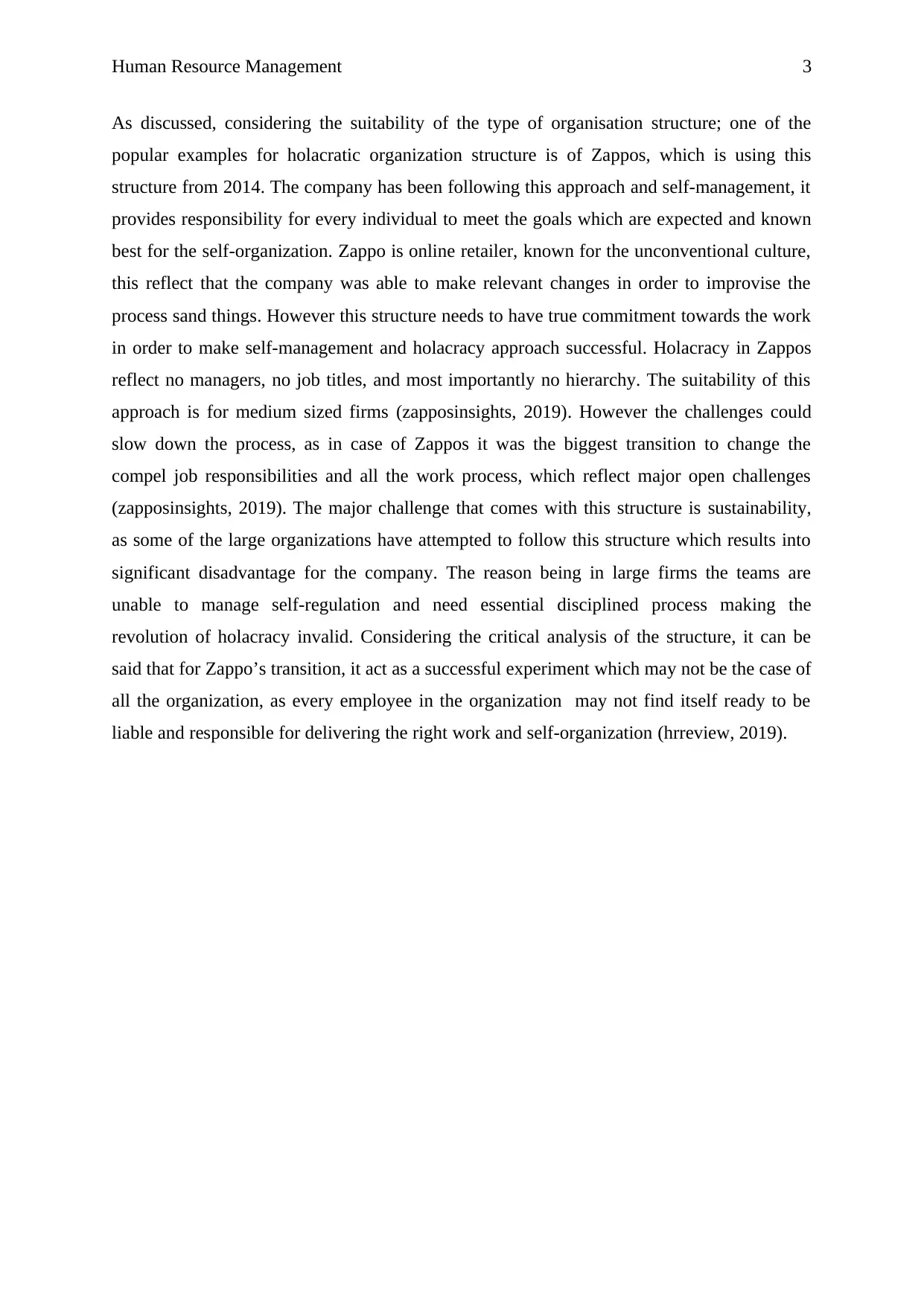
Human Resource Management 3
As discussed, considering the suitability of the type of organisation structure; one of the
popular examples for holacratic organization structure is of Zappos, which is using this
structure from 2014. The company has been following this approach and self-management, it
provides responsibility for every individual to meet the goals which are expected and known
best for the self-organization. Zappo is online retailer, known for the unconventional culture,
this reflect that the company was able to make relevant changes in order to improvise the
process sand things. However this structure needs to have true commitment towards the work
in order to make self-management and holacracy approach successful. Holacracy in Zappos
reflect no managers, no job titles, and most importantly no hierarchy. The suitability of this
approach is for medium sized firms (zapposinsights, 2019). However the challenges could
slow down the process, as in case of Zappos it was the biggest transition to change the
compel job responsibilities and all the work process, which reflect major open challenges
(zapposinsights, 2019). The major challenge that comes with this structure is sustainability,
as some of the large organizations have attempted to follow this structure which results into
significant disadvantage for the company. The reason being in large firms the teams are
unable to manage self-regulation and need essential disciplined process making the
revolution of holacracy invalid. Considering the critical analysis of the structure, it can be
said that for Zappo’s transition, it act as a successful experiment which may not be the case of
all the organization, as every employee in the organization may not find itself ready to be
liable and responsible for delivering the right work and self-organization (hrreview, 2019).
As discussed, considering the suitability of the type of organisation structure; one of the
popular examples for holacratic organization structure is of Zappos, which is using this
structure from 2014. The company has been following this approach and self-management, it
provides responsibility for every individual to meet the goals which are expected and known
best for the self-organization. Zappo is online retailer, known for the unconventional culture,
this reflect that the company was able to make relevant changes in order to improvise the
process sand things. However this structure needs to have true commitment towards the work
in order to make self-management and holacracy approach successful. Holacracy in Zappos
reflect no managers, no job titles, and most importantly no hierarchy. The suitability of this
approach is for medium sized firms (zapposinsights, 2019). However the challenges could
slow down the process, as in case of Zappos it was the biggest transition to change the
compel job responsibilities and all the work process, which reflect major open challenges
(zapposinsights, 2019). The major challenge that comes with this structure is sustainability,
as some of the large organizations have attempted to follow this structure which results into
significant disadvantage for the company. The reason being in large firms the teams are
unable to manage self-regulation and need essential disciplined process making the
revolution of holacracy invalid. Considering the critical analysis of the structure, it can be
said that for Zappo’s transition, it act as a successful experiment which may not be the case of
all the organization, as every employee in the organization may not find itself ready to be
liable and responsible for delivering the right work and self-organization (hrreview, 2019).
Paraphrase This Document
Need a fresh take? Get an instant paraphrase of this document with our AI Paraphraser
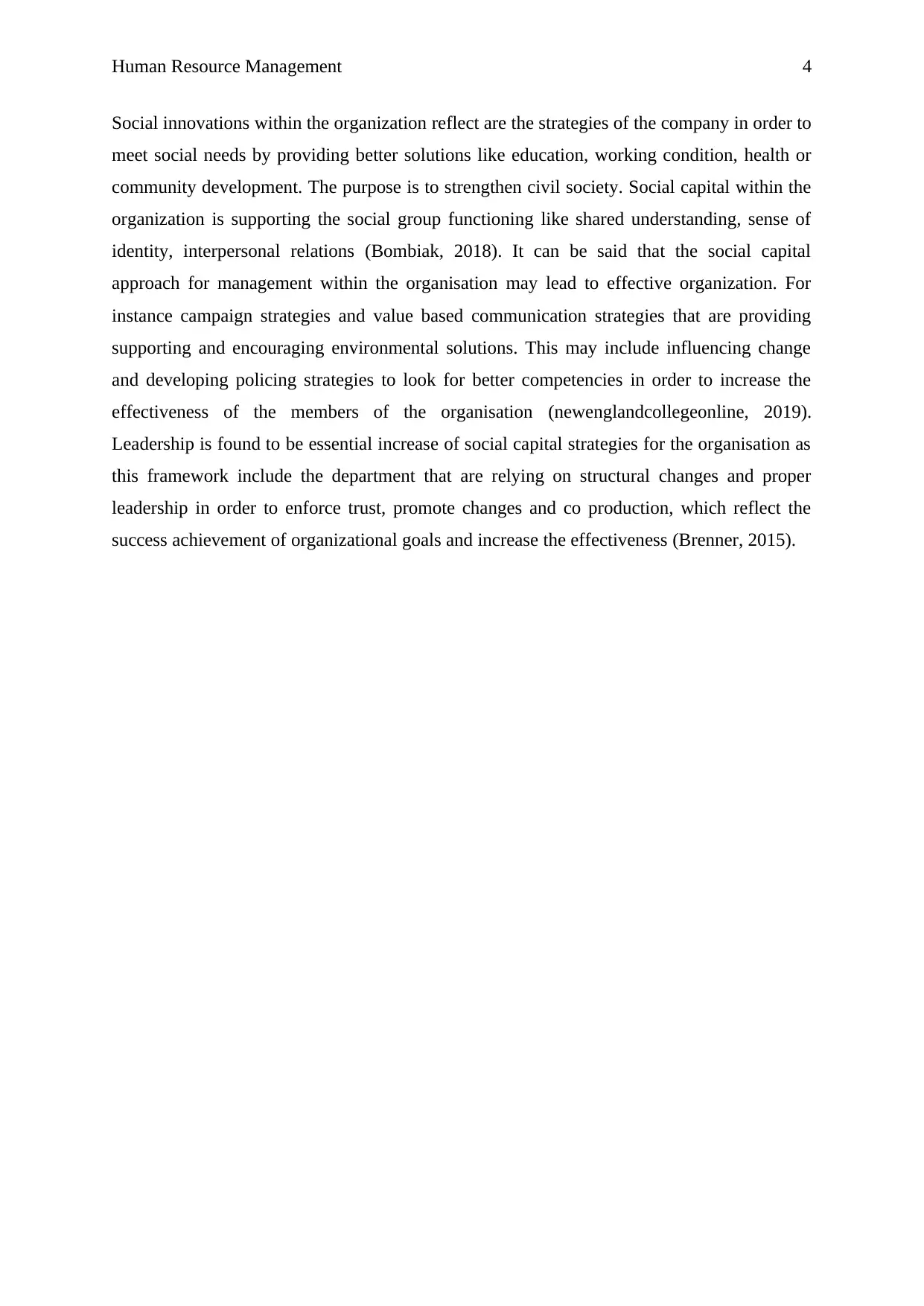
Human Resource Management 4
Social innovations within the organization reflect are the strategies of the company in order to
meet social needs by providing better solutions like education, working condition, health or
community development. The purpose is to strengthen civil society. Social capital within the
organization is supporting the social group functioning like shared understanding, sense of
identity, interpersonal relations (Bombiak, 2018). It can be said that the social capital
approach for management within the organisation may lead to effective organization. For
instance campaign strategies and value based communication strategies that are providing
supporting and encouraging environmental solutions. This may include influencing change
and developing policing strategies to look for better competencies in order to increase the
effectiveness of the members of the organisation (newenglandcollegeonline, 2019).
Leadership is found to be essential increase of social capital strategies for the organisation as
this framework include the department that are relying on structural changes and proper
leadership in order to enforce trust, promote changes and co production, which reflect the
success achievement of organizational goals and increase the effectiveness (Brenner, 2015).
Social innovations within the organization reflect are the strategies of the company in order to
meet social needs by providing better solutions like education, working condition, health or
community development. The purpose is to strengthen civil society. Social capital within the
organization is supporting the social group functioning like shared understanding, sense of
identity, interpersonal relations (Bombiak, 2018). It can be said that the social capital
approach for management within the organisation may lead to effective organization. For
instance campaign strategies and value based communication strategies that are providing
supporting and encouraging environmental solutions. This may include influencing change
and developing policing strategies to look for better competencies in order to increase the
effectiveness of the members of the organisation (newenglandcollegeonline, 2019).
Leadership is found to be essential increase of social capital strategies for the organisation as
this framework include the department that are relying on structural changes and proper
leadership in order to enforce trust, promote changes and co production, which reflect the
success achievement of organizational goals and increase the effectiveness (Brenner, 2015).
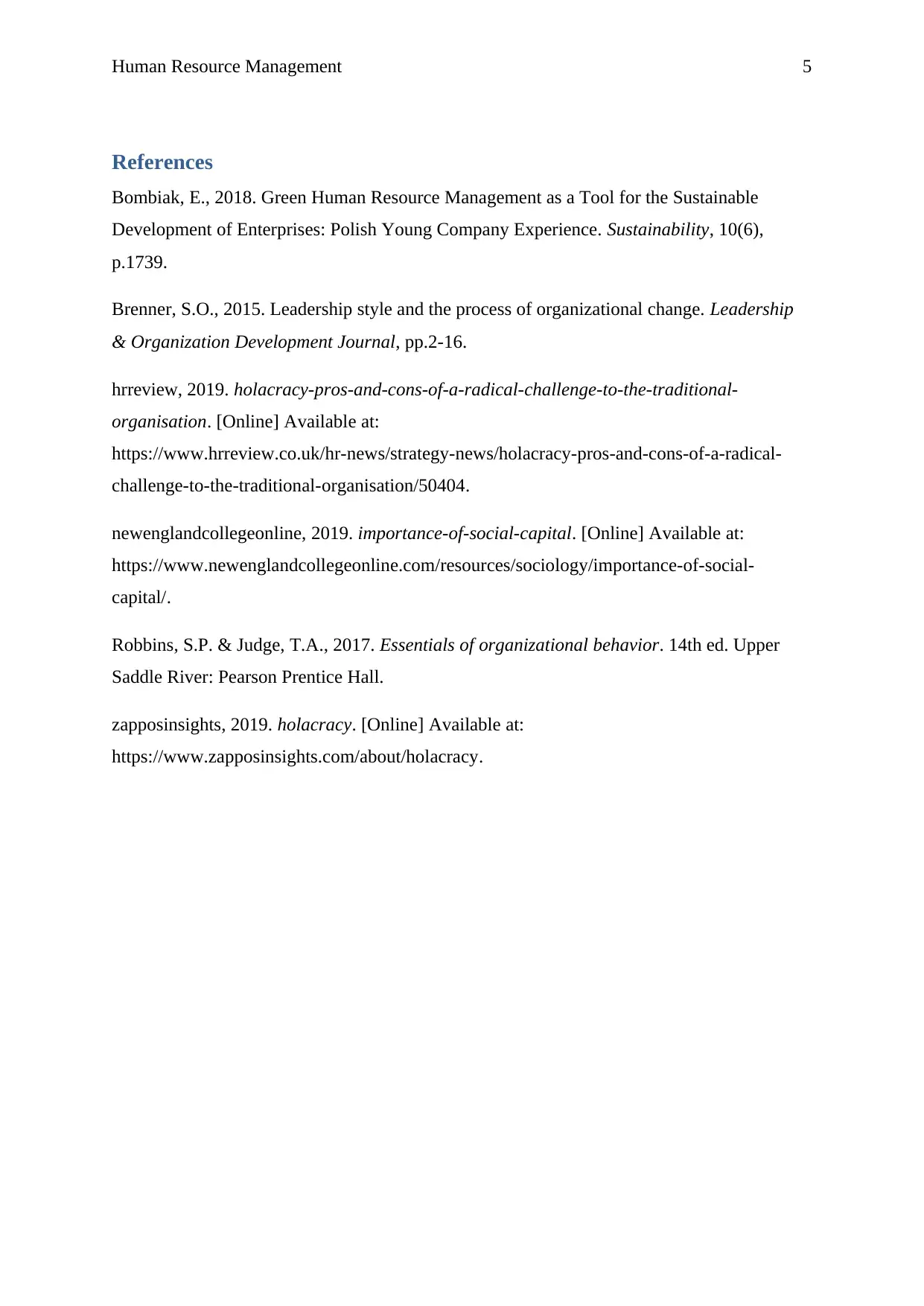
Human Resource Management 5
References
Bombiak, E., 2018. Green Human Resource Management as a Tool for the Sustainable
Development of Enterprises: Polish Young Company Experience. Sustainability, 10(6),
p.1739.
Brenner, S.O., 2015. Leadership style and the process of organizational change. Leadership
& Organization Development Journal, pp.2-16.
hrreview, 2019. holacracy-pros-and-cons-of-a-radical-challenge-to-the-traditional-
organisation. [Online] Available at:
https://www.hrreview.co.uk/hr-news/strategy-news/holacracy-pros-and-cons-of-a-radical-
challenge-to-the-traditional-organisation/50404.
newenglandcollegeonline, 2019. importance-of-social-capital. [Online] Available at:
https://www.newenglandcollegeonline.com/resources/sociology/importance-of-social-
capital/.
Robbins, S.P. & Judge, T.A., 2017. Essentials of organizational behavior. 14th ed. Upper
Saddle River: Pearson Prentice Hall.
zapposinsights, 2019. holacracy. [Online] Available at:
https://www.zapposinsights.com/about/holacracy.
References
Bombiak, E., 2018. Green Human Resource Management as a Tool for the Sustainable
Development of Enterprises: Polish Young Company Experience. Sustainability, 10(6),
p.1739.
Brenner, S.O., 2015. Leadership style and the process of organizational change. Leadership
& Organization Development Journal, pp.2-16.
hrreview, 2019. holacracy-pros-and-cons-of-a-radical-challenge-to-the-traditional-
organisation. [Online] Available at:
https://www.hrreview.co.uk/hr-news/strategy-news/holacracy-pros-and-cons-of-a-radical-
challenge-to-the-traditional-organisation/50404.
newenglandcollegeonline, 2019. importance-of-social-capital. [Online] Available at:
https://www.newenglandcollegeonline.com/resources/sociology/importance-of-social-
capital/.
Robbins, S.P. & Judge, T.A., 2017. Essentials of organizational behavior. 14th ed. Upper
Saddle River: Pearson Prentice Hall.
zapposinsights, 2019. holacracy. [Online] Available at:
https://www.zapposinsights.com/about/holacracy.
⊘ This is a preview!⊘
Do you want full access?
Subscribe today to unlock all pages.

Trusted by 1+ million students worldwide
1 out of 6
Related Documents
Your All-in-One AI-Powered Toolkit for Academic Success.
+13062052269
info@desklib.com
Available 24*7 on WhatsApp / Email
![[object Object]](/_next/static/media/star-bottom.7253800d.svg)
Unlock your academic potential
Copyright © 2020–2025 A2Z Services. All Rights Reserved. Developed and managed by ZUCOL.




